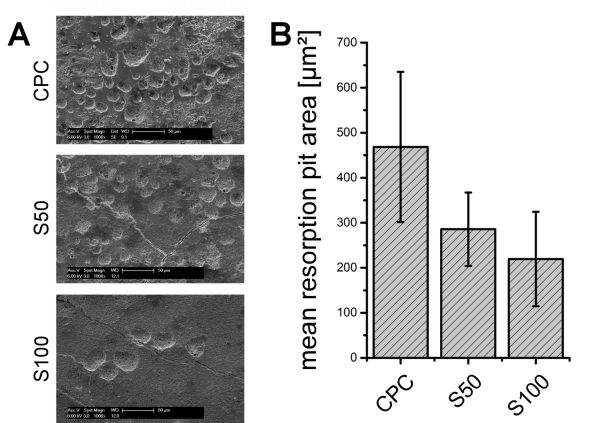Introduction: Since strontium was discovered to exert a stimulating effect on the bone turnover[1] a number of approaches have been proposed to obtain Sr-releasing bone cements for the local delivery of therapeutically active Sr-ions into a specific bone defect[2]. However, while the stimulating effect of several cement formulations on bone forming cells has been demonstrated in vitro[3] and some in vivo studies revealed a positive effect of such substitution on bone defect healing, no studies on the osteoclastic resorption of Sr-laden calcium phosphate cements (SrCPC) have been published so far. In this work we demonstrate how SrCPC do not prevent osteoclastogenesis but effectively reduce the osteoclastic resorption activity in vitro which might be beneficial for applications in systemically altered, especially osteoporotic bone lesions.
Materials and Methods: SrCPC were obtained by substitution of Ca2+ with Sr2+ via partial or total replacement of CaCO3 by SrCO3 (denoted as S50 and S100, respectively) in an α-TCP based, hydroxyapatite forming cement system (CPC)[3]. Sr-ion release in cell culture media was studied using ICP-MS and the effect of corresponding Sr-concentrations on osteoclast-like cells (OC) obtained from human buffy-coat derived primary monocytes via stimulation with M-CSF and RANKL was studied. Furthermore, cells were directly seeded on SrCPC and analysed with respect to morphology, gene expression (TRAP, Cathepsin K) and enzyme activity of OC markers (TRAP, carbonic anhydrase II) as well as resorption pit formation. Intracellular Sr-concentration was assessed using time-of-flight secondary ion mass spectrometry (ToF-SIMS).
Results and Discussion: SrCPC were shown to sustainably release 0.05-0.15 mM strontium depending on the degree of substitution. OC-related enzyme activity was reduced at >0.01 mM strontium, but formation of OC-like cells could be detected up to 1 mM strontium. Accordingly multinucleated, TRAP-positive cells could be found on SrCPC as well as on the Sr-free reference. This is of importance, since the presence of OC in the bone regenerative niche and their expression of paracrine factors is crucial for bone healing. OC-specific gene expression as well as activity of OC marker enzymes was altered, however not uniformly reduced on SrCPC. In contrast, a drastic decrease of resorption activity with increasing strontium content by means of resorption pit formation (Fig. 1A) and diameter (B) could be detected on SrCPC, which could be related to the intracellular uptake of Sr2+ (ToF-SIMS).

Figure 1: SEM imaging of resorption pits on CPC and Sr-releasing cements S50 and S100 (A) as well as quantitative evaluation of the resorption pit area (B).
Conclusions: In addition to their ability to stimulate bone forming cells[2],[3], SrCPC were shown to reduce the resorption activity, but not the formation of bone resorbing cells in vitro in this work. These findings could help to understand the overall stimulating effect of Sr-releasing cements on bone defect healing.
This work was funded by the DFG within the projects M2, M5 and B5 of the SFB Transregio 79.
References:
[1] Marie, P. J. Strontium as therapy for osteoporosis. Curr Opin Pharmacol, 2005, 5, 633-636.
[2] Schumacher, M. and Gelinsky, M. Strontium modified calcium phosphate cements – approaches towards targeted stimulation of bone turnover. J Mater Chem B, 2015. DOI: 10.1039/c5tb00654f
[3] Schumacher, M.; Lode, A.; Helth, A. and Gelinsky, M. A novel strontium(II)-modified calcium phosphate bone cement stimulates hMSC proliferation and osteogenic differentiation in vitro. Acta Biomater, 2013, 9, 9547-9557.